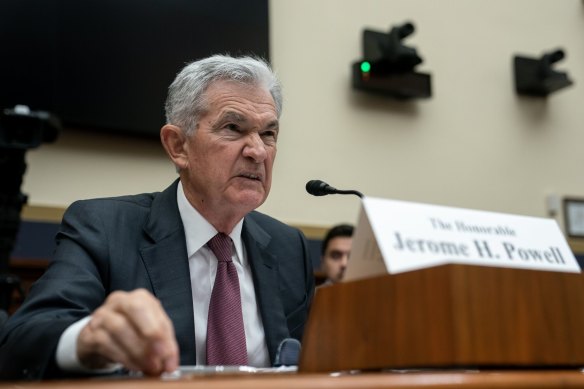Fed chair sees ‘long way to go’ on inflation fight
Save articles for later
Add articles to your saved list and come back to them any time.
Federal Reserve chair Jerome Powell said the United States remains a “long way” away from low and stable inflation even 15 months into the central bank’s campaign to cool the world’s largest economy and wrestle down rapid price increases.
Powell testified before the House Financial Services Committee on Wednesday. He told lawmakers that the labour market remained very tight and that inflation — while it has come down notably from its peak last summer — was still too fast. In light of that, the Fed could raise interest rates even higher than their current level of just above 5 per cent.
Jerome Powell: “Earlier in the process, speed was very important. It is not very important now.”Credit: Bloomberg
“Inflation has moderated somewhat since the middle of last year,” Powell said. “Nonetheless, inflation pressures continue to run high, and the process of getting inflation back down to 2 per cent has a long way to go.”
Fed officials left interest rates unchanged last week following 10 straight increases. But central bankers have been adamant that the decision to hit pause did not amount to a declaration of victory over inflation. Instead, moving more gradually will give policymakers time to assess how well higher rates are working to slow the economy as they try to strike a delicate balance of doing enough to cool growth without doing too much.
“Given how far we’ve come, it may make sense to move rates higher, but to do so at a more moderate pace,” Powell said in response to a lawmaker’s question, explaining that it was like moving from a highway to more local roads. “As you get closer to your destination, as you try to find that destination, you slow down even further.”
“Given how far we’ve come, it may make sense to move rates higher, but to do so at a more moderate pace.”
Central bankers forecast in their fresh economic projections last week that they will probably raise interest rates to around 5.6 per cent this year, which would amount to two more quarter-point rate increases. Powell said during his news conference following the decision last week that the Fed’s July 25-26 meeting will be “live,” meaning that a rate increase is possible at that gathering.
“I think that’s a pretty good guess of what will happen if the economy performs as about as expected,” Powell said on Wednesday, referring to Fed officials’ forecast for two more rate moves this year.
Powell’s comments prompted a muted pullback in the stock market as investors recalibrated their expectations over the future path of interest rates. Investors are now betting on another quarter-percentage point increase by the Fed by November. That’s still one less than what Fed policymakers forecast last week.
The Fed will need to assess how much the economy is slowing, and whether that is likely to be enough to return inflation to their 2 per cent goal over time, as officials decide what to do with rates. Overall growth and the housing market have cooled since 2021, but consumption and even home prices have shown recent signs of renewed strength and hiring has remained rapid.
And inflation itself has been sticky.
“Inflation has consistently surprised us, and essentially all other forecasters, by being more persistent than expected,” Powell said. “And I think we’ve come to expect that — expect it to be more persistent.”
Powell was asked about price increases globally. Many economists pointed to the United States’ large pandemic spending packages as a driver of the initial jump in inflation, but now inflation is beginning to fade in America even as it remains stubbornly very high in Europe and the United Kingdom.
“Our recovery is by far the strongest,” he said. “Everybody has very high inflation.”
He added that there’s a “common factor” that has driven price increases higher. “It’s the pandemic, and it’s everything about the pandemic: The closing of the economy, the reopening of the economy, the fiscal support, the monetary support. All the things that happened went into high inflation.”
This article originally appeared in The New York Times.
The Business Briefing newsletter delivers major stories, exclusive coverage and expert opinion. Sign up to get it every weekday morning.
Most Viewed in Business
From our partners
Source: Read Full Article


